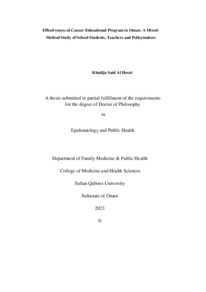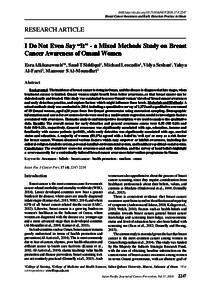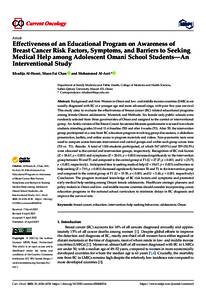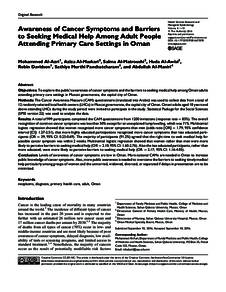Document
Effectiveness of cancer educational program in Oman : a mixed-method study of school students, teachers and policymakers.
Source
Doctoral dissertation
Other titles
فاعلية برنامج تعليمي حول التوعية بمرض السرطان من وجهة نظر طلاب المدارس والمعلمين ومتخذي القرار : دراسة مزجية في سلطنة عمان
Country
Oman
City
Muscat
Publisher
Sultan Qaboos University
Gregorian
2023
Language
English
Thesis Type
Doctoral dissertation
English abstract
Background: Cancer is considered a major cause of death worldwide, especially in
low- and middle-income countries. The disease is expected to increase worldwide for
various reasons, including the lack of awareness about cancer prevention, diagnosis
and treatment. Targeting school students through an educational program could be one
of the most effective methods of prevention or early detection. Currently, the school
curriculum does not include sufficient information for students on cancer risk factors
nor on how to seek early medical intervention. This necessitates introducing
educational and awareness-raising programs focusing on preventing and dealing with
the disease.
Aim: To evaluate the effectiveness of an interventional education cancer program
(general cancer and breast cancer) to enhance the knowledge and awareness of cancer
risk factors, symptoms and reduce the barriers to seeking early medical help among
Omani school students (grades 10–11) In addition, to explore the perceptions of
students, teachers and educational policymakers at the Ministry of Education regarding
the importance and challenges of including cancer awareness education in the school
curriculum.
Methods: The study employed a mixed-methods research design and was carried out
at three distinct research stages. The first two stages contained two phases; the first
phase was a quantitative randomized control trial (RCT), with control and intervention
groups via cancer awareness measures questionnaires (general and breast) targeted
school students (1716 for general cancer, both gender and 1106 for breast cancer,
female). The assessments were conducted twice; at baseline T0 and four weeks after;
T1. Then the qualitative phase with volunteers’ students from the intervention group
through focus groups discussion was conducted to explore their perception toward the
received program. The third stage was qualitative, through semi-structured interviews
with ten educational policymakers and ten teachers to explore their perception toward
inclusion of cancer education programs within the curriculum.
Results: The results showed a significant improvement four weeks after the
intervention (p 0.001) in students' awareness and knowledge about cancer risk factors
and symptoms. Significant improvement was also observed in the reduction in the time
the intervention group students required to seek medical help compared to those in the
control group. Also, a decrease in the number of students who indicated barriers to
seeking medical help was observed, with emotional barriers like embarrassment and
unconfident in talking about the symptoms being the most prominent (p 0.001).
However, there was a slight decrease in other barriers, such as scare (p = 0.263) and
worry about the finding (p = 0.408). Students also mentioned other practical and
service-related barriers, like unavailability of transportation and appointment delays.
The study also demonstrated an improvement in the female student's knowledge about
breast cancer-related examinations, including the availability of free services in the
Sultanate of Oman and the non-painful nature of the examination (p 0.001).
Furthermore, there was an association between the responses of the intervention group
students before the program and some socio-demographic factors, such as gender and
the presence of a family member with cancer (p 0.001). However, the impact of these
factors diminished significantly after the program as a result of the educational program
that all students in this group received.
Furthermore, the results showed that parents and healthcare providers are crucial in
seeking early medical help and addressing students' emotional, social, and educational
barriers. Also, the study revealed that policymakers and teachers had a positive attitude
towards the inclusion of the program and had a good recognition of the importance of
cancer education in schools. They also emphasized the need to prioritize such programs
due to the ever-increasing cancer cases in Oman.
The results also showed that implementing cancer education programs in schools is
crucial for enhancing students' knowledge of cancer, promoting healthy behavior, and
emphasizing the importance of integration and collaboration among different
departments. It was also noted that integrating cancer education into various school
activities is urgently necessary to reduce the prevalence of cancer in Oman. This stage
also explored the potential challenges of establishing school cancer education
programs. These challenges include prioritizing cancer education over other topics,
taking the necessary steps to have cancer education in the curriculum, and addressing
the financial and logistical requirements for implementing cancer education programs.
Conclusion: The study confirmed the effectiveness of the proposed cancer education
program and called upon incorporating the program into the school curriculum. The
study suggested solutions to address these challenges, such as educational
policymakers and teachers drawing up realistic and practical strategies to integrate
cancer education into the curriculum and providing appropriate training and support for
teachers to ensure a successful implementation of the programs.
Arabic abstract
الخلفية: يعتبر مرض السرطان سببا رئيسيا للوفاة حول العالم. وخاصة في البلدان ذات الدخل المنخفض والمتوسط . ومن المتوقع أن يزداد انتشار السرطان في مختلف دول العالم لأسباب مختلفة، بما في ذلك تغير نمط الحياة وقلة الوعي بطرق الوقاية من المرض، وكيفية تشخيصه وعلاجه. وقد أثبتت الأبحاث والدراسات المختلفة أن أحد وسائل حد انتشار وتوسعه نشر الوعي بمسبباته وأعراضه، وضرورة الفحص المبكر عنه ، وأن استهداف طلاب المدارس من خلال المنهج المدراسي قد يكون أحث الطرق فعالية.
الهدف: تقييم فعالية البرنامج التعليمي التعليمي التوعوي (حول السرطان بشكل عام وسرطان الثدي بشكل خاص) لطلاب المدارس الصفوف (10-11) كاستراتيجية لزيادة الوعي.
المنهجية: اعتمدت الدراسة تصميم البحث المزجي وتم تنفيذها على ثلاث مراحل متوالية.
النتائج:
أظهرت النتائج زيادة ملحوظة (P <0.001) في مستوى وعي الطلاب الذين تلقوا البرنامج التعليمي بعد أربعة أسابيع مقارنة بأنفسهم في الاختبار القبلي وبالمجموعة الضابطة. وايضا انخفاضا في عدد الذين الوقت الذي أشاروا بوجود موانع تحول دون طلب الاستشارة الطبية أبرزها العوامل النفسية مثل الإحراج وعدم امتلاك الثقة للحديث عن الأعراض (P <0.001). بينما كان الانخفاض طفيفا في عوائق أخرى مثل الخوف (0.263=p( والقلق من النتيجة (0.408=p(. كما أشار الطلاب إلى عوائق أخرى عملية وخدمية.
إليه طلاب هذه المجموعة لطلب المساعدة الطبية مقارنة بأولئك الموجودين في المجموعة الضابطة. كما انخفض عدد الطلاب الذين أشارت إليهم المعوقات
ولوحظ طلب المساعدة الطبية، مع وجود حواجز عاطفية مثل الإحراج وغير واثق من الحديث عن كون الأعراض هي الأبرز ومع ذلك، كان هناك انخفاض طفيف في الحواجز الأخرى، مثل الخوف (ع = 0.263) و
تقلق بشأن النتيجة (ع = 0.408). وذكر الطلاب أيضا عملية وأخرى العوائق المتعلقة بالخدمة، مثل عدم توفر وسائل النقل وتأخير المواعيد. السادس كما أظهرت الدراسة تحسنا في معرفة الطالبات حول الفحوصات المتعلقة بسرطان الثدي، بما في ذلك توافر الخدمات المجانية في سلطنة عمان وطبيعة الفحص غير المؤلمة (P <0.001).
الخاتمة: أثبتت الدراسة فعالية برنامج التثقيف الصحي بمرض السرطان المقترح.
الهدف: تقييم فعالية البرنامج التعليمي التعليمي التوعوي (حول السرطان بشكل عام وسرطان الثدي بشكل خاص) لطلاب المدارس الصفوف (10-11) كاستراتيجية لزيادة الوعي.
المنهجية: اعتمدت الدراسة تصميم البحث المزجي وتم تنفيذها على ثلاث مراحل متوالية.
النتائج:
أظهرت النتائج زيادة ملحوظة (P <0.001) في مستوى وعي الطلاب الذين تلقوا البرنامج التعليمي بعد أربعة أسابيع مقارنة بأنفسهم في الاختبار القبلي وبالمجموعة الضابطة. وايضا انخفاضا في عدد الذين الوقت الذي أشاروا بوجود موانع تحول دون طلب الاستشارة الطبية أبرزها العوامل النفسية مثل الإحراج وعدم امتلاك الثقة للحديث عن الأعراض (P <0.001). بينما كان الانخفاض طفيفا في عوائق أخرى مثل الخوف (0.263=p( والقلق من النتيجة (0.408=p(. كما أشار الطلاب إلى عوائق أخرى عملية وخدمية.
إليه طلاب هذه المجموعة لطلب المساعدة الطبية مقارنة بأولئك الموجودين في المجموعة الضابطة. كما انخفض عدد الطلاب الذين أشارت إليهم المعوقات
ولوحظ طلب المساعدة الطبية، مع وجود حواجز عاطفية مثل الإحراج وغير واثق من الحديث عن كون الأعراض هي الأبرز ومع ذلك، كان هناك انخفاض طفيف في الحواجز الأخرى، مثل الخوف (ع = 0.263) و
تقلق بشأن النتيجة (ع = 0.408). وذكر الطلاب أيضا عملية وأخرى العوائق المتعلقة بالخدمة، مثل عدم توفر وسائل النقل وتأخير المواعيد. السادس كما أظهرت الدراسة تحسنا في معرفة الطالبات حول الفحوصات المتعلقة بسرطان الثدي، بما في ذلك توافر الخدمات المجانية في سلطنة عمان وطبيعة الفحص غير المؤلمة (P <0.001).
الخاتمة: أثبتت الدراسة فعالية برنامج التثقيف الصحي بمرض السرطان المقترح.
Category
Theses and Dissertations




